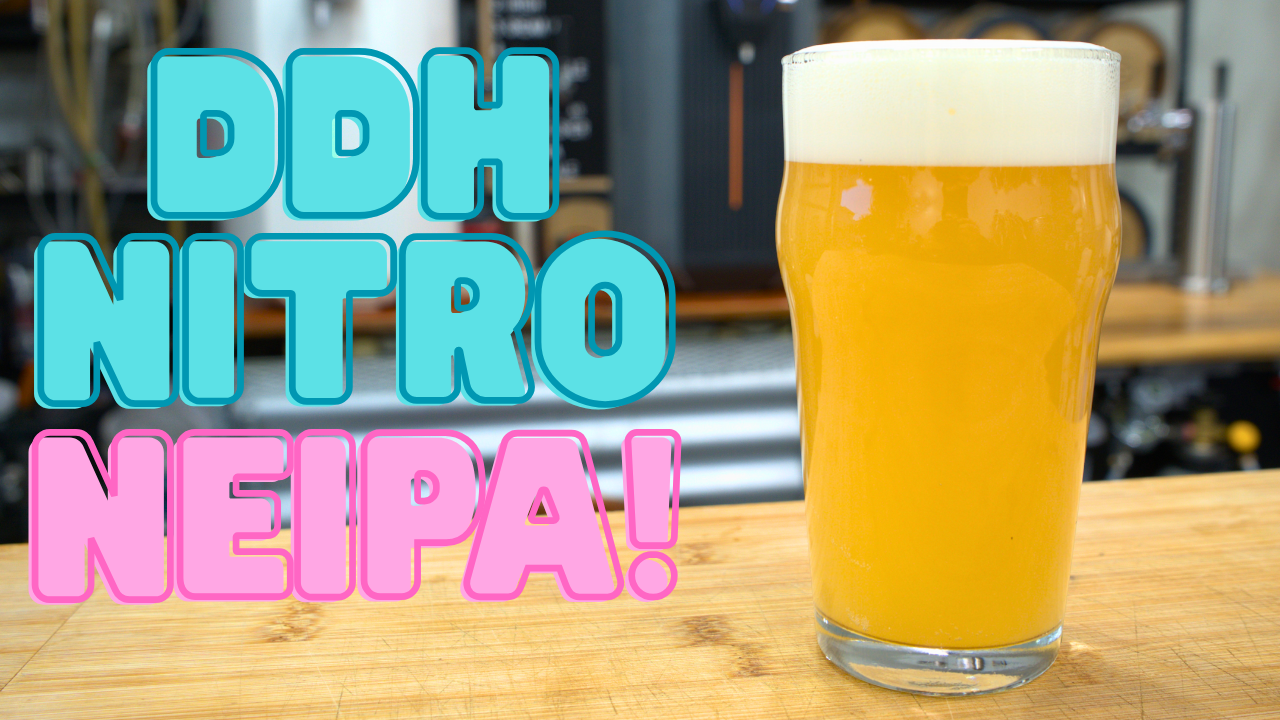Double Dry Hopped Nitro NEIPA!

So... What is it?
How do you make a juicy NEIPA even juicier? You throw it on NITRO! This 7% hazy beast is an absolute game-changer – by far the creamiest, silkiest NEIPA we’ve ever brewed. That cascading nitro pour gives it a dreamy, pillowy mouthfeel that’s smoother than velvet. Packed with mountains of hops, it’s dripping with tropical fruit, citrus, and candy-like sweetness. And because we don’t do things by halves, we hit it with not one, but TWO massive rounds of dry hopping – including a biotransformation charge – to supercharge those juicy, aromatic hop oils.
Batch Size & ABV
- Style: Hazy IPA (NEIPA)
- Batch Size: 25 L (6.6 gal)
- OG: 1.065
- FG: 1.014
- ABV: 6.7%
- IBU: 32 (Tinseth)
- Colour: 10 EBC (5 SRM)
- BU/GU: 0.5
Ingredients
Water
- Mash Water: 24 L (6.34 gal)
- Sparge Water: 10 L (2.64 gal)
- Total Water: 34 L (8.98 gal)
- Mash Schedule:
- 69 °C (156 °F) – 60 min
- 77 °C (171 °F) – 10 min Mash Out
- Mash Schedule:
- Water Profile: Ca 130 | Mg 16 | Na 15 | Cl 202 | SO₄ 100 (SO₄/Cl ratio: 0.5)
-
Grain Bill (7.33 kg / 16.15 lbs)
- 4.398 kg (9.7 lbs) Ale Malt (60%)
- 1.10 kg (2.43 lbs) Gladfield Rolled Oats (15%)
- 1.026 kg (2.26 lbs) Gladfield Wheat Malt (14%)
- 513 g (1.13 lbs) Gladfield Rolled Wheat (7%)
- 293 g (0.65 lbs) Gladfield Gladiator Malt (4%)
- 510 g (1.12 lbs) Rice Hulls (for lautering aid)
Hops & whirlfloc tablets
Mash Hop:
- 18 g (0.63 oz) Motueka (7%) – 3 IBU
Hopstand @ 78°C (172°F) for 20 min:
- 44 g (1.55 oz) El Dorado (11.6%)
- 44 g (1.55 oz) El Dorado (11.6%)
- 44 g (1.55 oz) Amarillo Lupomax (13.5%)
- 44 g (1.55 oz) Citra Lupomax (18.5%)
- 44 g (1.55 oz) Superdelic (10.5%)
Dry Hops:
- Day 2 or 3 (Biotransformation):
- 18 g (0.63 oz) Amarillo Lupomax
- 18 g (0.63 oz) Citra Lupomax
- 18 g (0.63 oz) El Dorado Lupomax
- 18 g (0.63 oz) Superdelic
- Day 7 (Near FG):
- 38 g (1.34 oz) Amarillo Lupomax
- 38 g (1.34 oz) Citra Lupomax
- 38 g (1.34 oz) El Dorado Lupomax
- 38 g (1.34 oz) Superdelic
Yeast options & fermentation temperatures
- 22 g (0.8 oz) — Lallemand (LalBrew) Pomona - 22 °C (71.6 °F)
alternatives below
- 23g (0.8 oz) Lallmand East Coast New England Ale Yeast ferment at 25°C (55°F)
- 23g (0.8 oz) Kveik (we used a Omega yeats Espe Kveik, but any kveik is great!) ferment at 32°C
- 23g (0.8 oz) US-05 – ferment at 20°C
- 23g (0.8 oz) S-04 – ferment at 19°C
Step by step process
Step 1 – Milling
- Mill grains to medium crush (set mill rollers to a gap of approx. 1mm / 0.039 inches) (BUT DONT crush the rice hulls or oats, add them into your grain separately after crushing them)
- Just keep in mind roller gap settings are not universal so as you brew more batches you will find the ideal crush size for your setup
- Alternatively if you don’t have a grain mill you can order your grains crushed from most homebrew stores, both online and in person
Step 2 – Mashing
- Add your brewing salts and mix to ensure they are fully dissolved prior to mashing in grains
- Mash for 60 minutes at 69°C (156°F)
- ensure you mix in the grains thoroughly with a mash paddle to prevent dough balls from forming (big spoons, spatulas or whisks will also work)
- its easier to mash the grains and prevent dough balls if you add a little grain at a time, mix, add more grain and repeat until all the grains are mixed
- now add your mash hops!! This is going to free a bunch of bound thiols from your hops and make this beer even more juicy! I would recommend adding these in a hop bag to make sure you can remove all the hop particles before you start boiling so you don't get extra unaccounted bitterness
- if you don’t have a mash tun with heating then ensure after you have finished mixing the grains in to insulate your mash tun (thick neoprene or heavy blankets both work well)
- after 60 minutes of mashing raise temperature to 77°C (170°F) for 10 minutes to Mash out
Step 3 (optional) – Sparging
- if your setup has the capability to sparge then do so with 25L (6.6 gal) of sparge water at 78 °C (172°F)
- if you are not sparging and using a BIAB (brew in a bag) method then remove grains from mash tun and twist and squeeze the bag to get as much liquid out of the grains as possible
- as you start sparging (or straining your BIAB bag) begin raising the temperature of your wort to a boil
Step 4 – Boiling
- once your wort begins to boil start a timer for a 60-minutes
- after 60 minutes of boiling turn of the heat and chill the temperature of the wort down to 78°C (172°F) and begin whirlpooling
- if you don’t have a wort chiller you could rest your boil kettle in an ice bucket
- if your system can’t whirlpool you can also achieve this with a mash paddle and a power drill, if you don’t have this either don’t worry about whirlpooling it’s not completely necessary
Step 5 – Whirlpooling / whirlpool hop additions
- once temperature reaches 75°C (167°F) and you have started whirlpooling add your whirlpool hops, 44 g - 1.55 oz each of Lupomax citra, Amarillo and regular Superdelic & El Dorado
- allow hops to whirlpool in the wort for 20 minutes and then begin chilling wort again down to yeast pitching temperature
- once you’ve reached yeast pitching temperature take an original gravity reading of your wort
Step 6 – Yeast Pitching
- It is best to make a yeast starter before beginning your brew day (ideally 1 day before) to ensure your yeast are as active and healthy as possible before pitching, but not completely necessary – you could also just rehydrate yeast 30 minutes before pitching.
- Pitch yeast in wort a degree or two higher than the target fermentation temperature to help yeast take off more aggressively
- To make a yeast starter you can use either:
- DME (dry malt extract) at a ratio of approx. 100g per 1L water (3.5 oz per 33 fluid ounces) for gravity of approx. 1.040
- some unfermented wort kept cold and sanitary from a previous brew day
- 70g of table sugar per 1L water (2.5 oz per 33 fluid ounces) – however, it is best to use malt sugar (wort / DME) whenever possible to reduce the chance of shocking the yeast with a different food source from starter to wort pitching
- To rehydrate yeast
- Add yeast to approx. 10 times as much room temperature water as the weight of the yeast e.g. 10g yeast in 100 ml water (0.35 oz yeast in 3.5 fluid ounces water)
Step 7 – Fermentation, dry hopping and Soft Crashing (optional)
- After 2 to 3 days of fermentation add your first round of dry hops, we are aiming for a high krausen hop addition to maximise biotransformation
- after 2-3 days of contact time remove these hops (either bu trub dumping if you can, or add your hops in a hop back with a magnet and pull them out)
- Allow yeast to ferment over the next 5 days to a week
- When the gravity reaches around 1.016 raise the temperature of your fermenter by 1-2 degrees for 2 days for a diacetyl rest
- Whilst starting your Diacetyl rest add your second round of dry hops
- 2 days after dry hopping move on to cold crashing and dump trub / remove hops and take a final gravity reading
- (If you can’t / don’t want to cold crash go straight to kegging/bottling your beer!)
Step 8 (optional) – Cold crashing
- begin cold crashing your fermenter (bring the temperature of your fermenter down to as close to 0°C (32°F) as possible, for 2 days to a week depending on how patient you are
- If you don’t have a temp-controlled fermenter, you can cold crash by putting your fermenter in a fridge or temp-controlled chest freezer
- After you have finished cold crashing it's time to keg/bottle your beer! If you are bottling your beer from the fermenter uncarbonated remember to add about 5-7 grams (0.17 - 0.24 oz) of priming sugar to your bottles to carbonate your beer.


